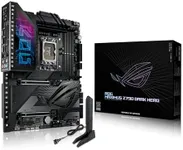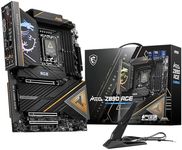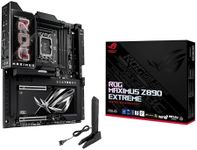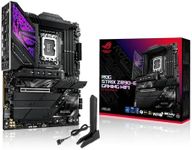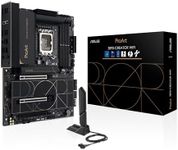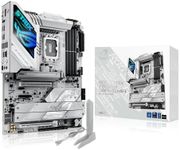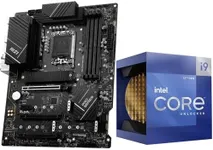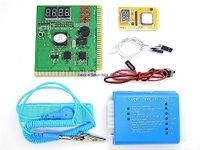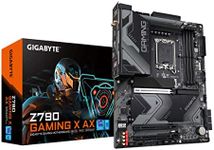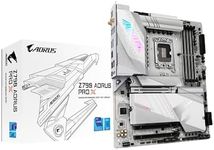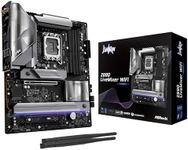Buying Guide for the Best Motherboard For Intel I9
Choosing the right motherboard for your Intel i9 processor is crucial for ensuring optimal performance and compatibility. The motherboard is the backbone of your computer, connecting all the components and allowing them to communicate with each other. When selecting a motherboard, you need to consider several key specifications to ensure it meets your needs and supports your Intel i9 processor effectively.ChipsetThe chipset is a crucial component of the motherboard that determines its capabilities and compatibility with your Intel i9 processor. It manages data flow between the processor, memory, and peripherals. For Intel i9 processors, you should look for motherboards with high-end chipsets like Z-series (e.g., Z490, Z590) which offer better performance, overclocking capabilities, and support for the latest technologies. If you are a gamer or a power user, a Z-series chipset is recommended. For more basic needs, an H-series chipset might suffice, but it will have fewer features and lower performance.
Form FactorThe form factor of a motherboard determines its size and the type of case it will fit into. The most common form factors are ATX, Micro-ATX, and Mini-ITX. ATX motherboards are the largest and offer the most features and expansion slots, making them ideal for high-performance builds. Micro-ATX boards are smaller and have fewer expansion slots but can still offer good performance for most users. Mini-ITX boards are the smallest and are suitable for compact builds, but they have limited expansion options. Choose a form factor based on your case size and the number of components you plan to install.
RAM SupportRAM support refers to the type and amount of memory that the motherboard can handle. For an Intel i9 processor, you should look for a motherboard that supports DDR4 or DDR5 RAM, with higher frequencies providing better performance. The number of RAM slots is also important; more slots allow for greater memory capacity. If you plan to run memory-intensive applications or multitask heavily, opt for a motherboard with at least four RAM slots and support for higher memory capacities (e.g., 64GB or more).
Expansion SlotsExpansion slots are used to add additional components like graphics cards, sound cards, and network cards to your system. The most important type of expansion slot for an Intel i9 build is the PCIe (Peripheral Component Interconnect Express) slot. Look for motherboards with multiple PCIe x16 slots if you plan to use multiple graphics cards or other high-bandwidth components. For general use, a single PCIe x16 slot may be sufficient, but having additional slots provides more flexibility for future upgrades.
Storage OptionsStorage options on a motherboard include the types and number of storage devices it can support. Look for motherboards with multiple SATA ports for traditional hard drives and SSDs, as well as M.2 slots for faster NVMe SSDs. M.2 slots are particularly important for high-performance builds, as they offer significantly faster data transfer speeds compared to SATA. If you plan to use multiple storage devices or need high-speed storage, ensure the motherboard has enough SATA ports and M.2 slots to meet your needs.
ConnectivityConnectivity options on a motherboard include USB ports, Ethernet ports, Wi-Fi, and Bluetooth. For an Intel i9 build, having a variety of USB ports (including USB 3.0 and USB-C) is important for connecting peripherals and external devices. Ethernet ports are essential for wired internet connections, while built-in Wi-Fi and Bluetooth can be convenient for wireless connectivity. Consider your connectivity needs and choose a motherboard that offers the right combination of ports and wireless features.
Power DeliveryPower delivery refers to the motherboard's ability to provide stable and sufficient power to the processor and other components. This is especially important for high-performance processors like the Intel i9, which require more power. Look for motherboards with robust VRM (Voltage Regulator Module) designs and high-quality power phases to ensure stable power delivery, especially if you plan to overclock your processor. A good power delivery system helps maintain system stability and performance under heavy loads.
BIOS/UEFIThe BIOS (Basic Input/Output System) or UEFI (Unified Extensible Firmware Interface) is the firmware that initializes and manages the hardware components of your system. A user-friendly BIOS/UEFI interface with advanced features can make it easier to configure and optimize your system. Look for motherboards with a well-designed BIOS/UEFI that offers features like easy overclocking, hardware monitoring, and firmware updates. This can be particularly useful for enthusiasts who want to fine-tune their system's performance.


